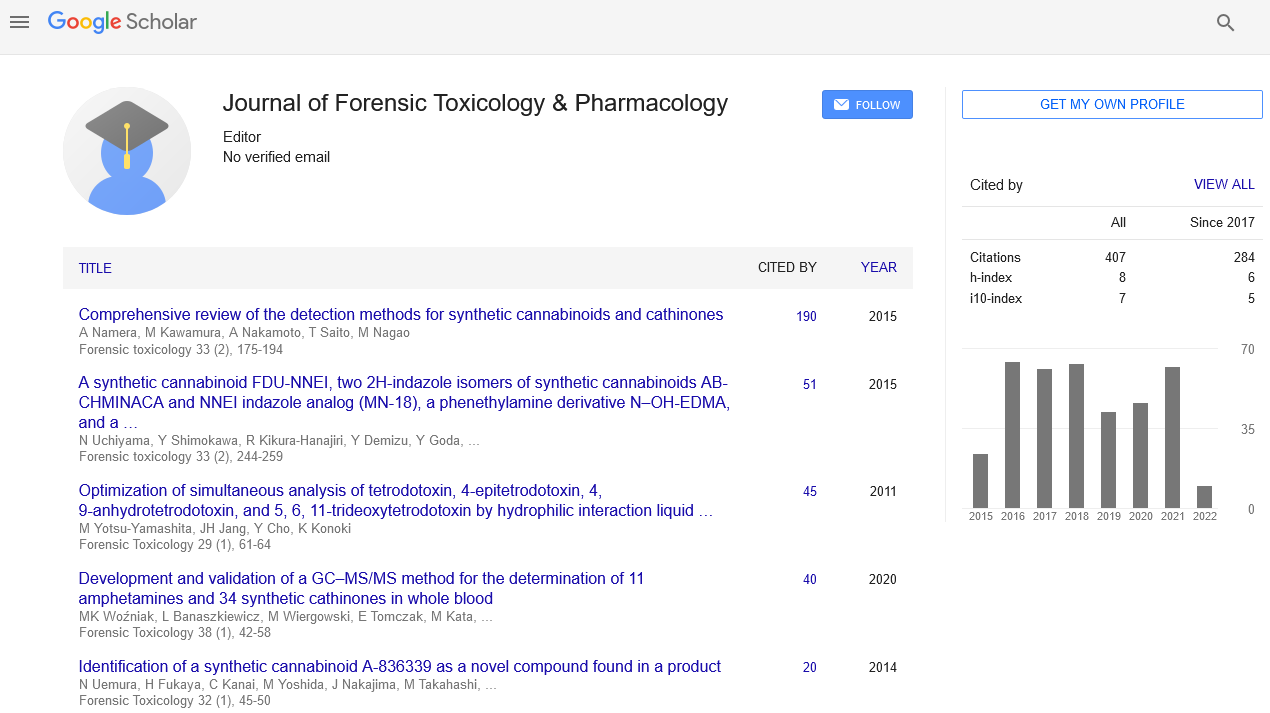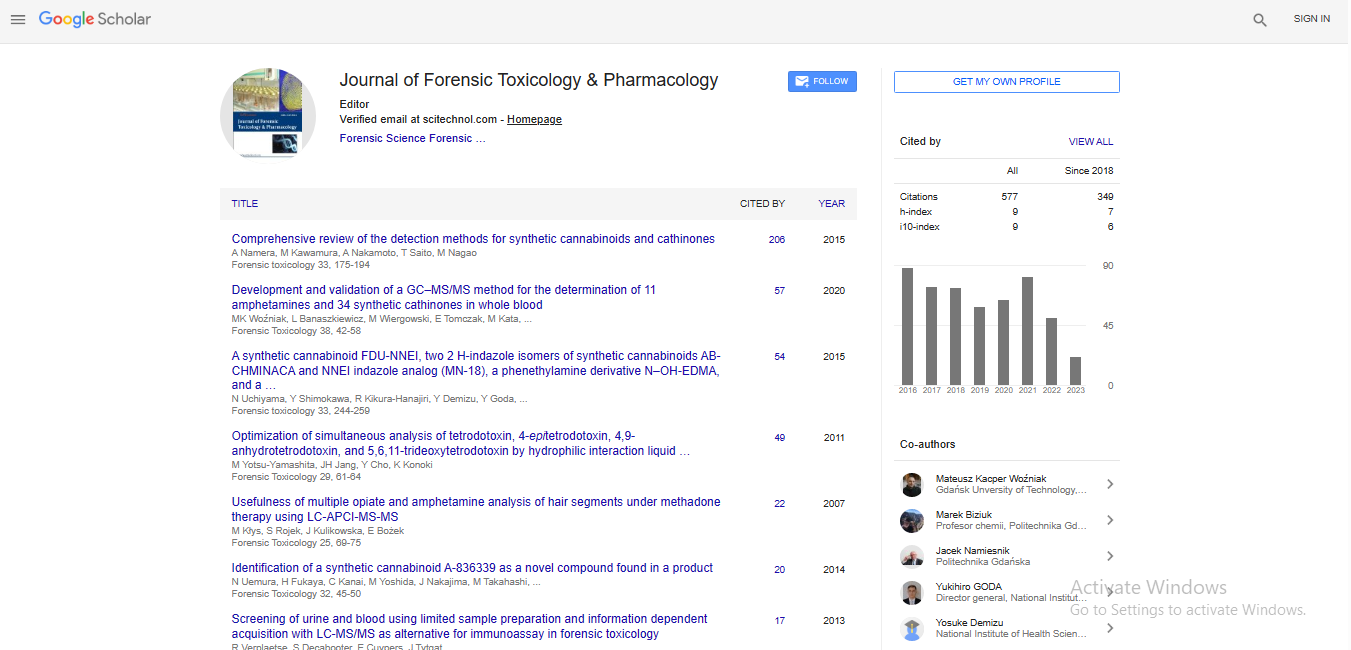Short Communication, J Forensic Toxicol Pharmacol Vol: 13 Issue: 4
Integrating Toxicodynamics and Toxicokinetics for Predictive Modeling
Dorne Niemeijer*
1Department of Cyber Forensic, University of Sao Paulo, Sao Paulo, Brazil
*Corresponding Author: Dorne Niemeijer,
Department of Cyber Forensic, University
of Sao Paulo, Sao Paulo, Brazil
E-mail: niemeijerdorne@gmail.com
Received date: 26 November, 2024, Manuscript No. JFTP-24-156313;
Editor assigned date: 28 November, 2024, PreQC No. JFTP-24-156313 (PQ);
Reviewed date: 12 December, 2024, QC No JFTP-24-156313;
Revised date: 19 December, 2024, Manuscript No. JFTP-24-156313 (R);
Published date: 26 December, 2024, DOI: 10.4172/JFTP.1000213
Citation: Niemeijer D (2024) Integrating Toxicodynamics and Toxicokinetics for Predictive Modeling. J Forensic Toxicol Pharmacol 13:4.
Description
The integration of toxicodynamics and toxicokinetics is becoming an important strategy in the development of predictive models for toxicological assessment. Toxicodynamics refers to the study of the effects of toxic substances on living organisms, including the mechanisms through which these effects occur, while toxicokinetics deals with how the body absorbs, distributes, metabolizes and eliminates these substances. By combining these two difficult aspects of toxicology, scientists are now able to create more accurate and comprehensive predictive models that better forecast a chemical's toxicity, enhancing both safety assessments and drug development processes [1-3].
Toxicokinetics involves the study of how a substance moves through the body. It provides important data on how long a chemical stays in the body, at what concentrations and in which tissues it accumulates. This information is important because the concentration of a toxic substance in specific organs or tissues directly influences its toxic effects. For instance, a substance may be harmless in small amounts but become toxic at higher concentrations or after prolonged exposure. Understanding the pharmacokinetics of a substance can help predict its toxicity profile, such as the likelihood of organ damage or systemic toxicity [4-6].
On the other hand, toxicodynamics examines the biological effects of chemicals once they have entered the body. It focuses on understanding how a substance interacts with cells, tissues and organs to produce harmful effects. This field of study seeks to uncover the molecular and cellular mechanisms underlying toxic responses, such as enzyme inhibition, receptor binding, or DNA damage. By integrating toxicodynamics into predictive models, scientists can anticipate the specific mechanisms through which a substance may cause toxicity, whether through acute effects like organ failure or longterm effects such as carcinogenesis [7].
By combining toxicokinetics and toxicodynamics in predictive modeling, scientists can create a more integrated view of a substance’s potential effects. For example, a model that integrates both aspects can simulate how a drug or chemical behaves in the body (toxicokinetics) and predict the specific biological processes that will be affected (toxicodynamics). This integration allows for a more accurate prediction of both the onset and severity of toxic effects.
One of the key advantages of integrating toxicodynamics and toxicokinetics is the ability to predict toxicity across different species, including humans. Since animals and humans may metabolize and respond to chemicals differently, predictive models that take both pharmacokinetic and dynamic data into account can better estimate the risk to humans. Moreover, this integration can help to identify vulnerable populations who may be at greater risk, such as those with specific genetic mutations or pre-existing conditions [8,9].
Modern computational methods, including machine learning and systems biology, are enhancing the integration of these two areas of toxicology. Machine learning algorithms can analyze complex data sets from both toxicokinetic and toxicodynamic studies, identifying patterns and relationships that may not be obvious from individual experiments. Additionally, systems biology approaches, which model the interactions between biological systems at multiple levels (e.g., molecular, cellular and organ levels), can simulate how a substance will affect the entire organism. These tools provide a deeper, more interconnected understanding of toxicity, facilitating the development of more accurate predictive models [10].
Conclusion
Ultimately, the integration of toxicodynamics and toxicokinetics in predictive modeling holds great promise for improving safety testing in drug development, chemical regulation and environmental risk assessment. By providing a more comprehensive understanding of how substances interact with the body and produce harmful effects, these integrated models can help identify toxic risks more efficiently, reducing the reliance on animal testing and enhancing public health protection. As research and technology continue to evolve, these integrated models will play an increasingly important role in ensuring the safety of pharmaceuticals and chemicals before they are introduced into the market.
References
- VonVoigtlander PF, Straw RN (1985) Alprazolam: Review of pharmacological, pharmacokinetic and clinical data. Drug Dev Res 6:1–12.
- Temte V, Kjeldstadli K, Bruun LD, Morris B, Liliana B, et al. (2019) An experimental study of diazepam and alprazolam kinetics in urine and oral fluid following single oral doses. J Anal Toxicol 43:104–111.
- Kampfrath T, Peng P, Vairavan V, Lee D (2015) Benzodiazepine in a urine specimen without drug metabolites. Lab Med 46:164–167.
- Hirota N, Ito K, Iwatsubo T, Green CE, Tyson CA, et al. (2001) In vitro/in vivo scaling of alprazolam metabolism by CYP3A4 and CYP3A5 in humans. Biopharm Drug Dispos 22:53–71.
- Allqvist A, Miura J, Bertilsson L, Mirghani RA (2007) Inhibition of CYP3A4 and CYP3A5 catalyzed metabolism of alprazolam and quinine by ketoconazole as racemate and four different enantiomers. Eur J Clin Pharmacol 63:173–179.
- Smith RB, Kroboth PD (1987) Influence of dosing regimen on alprazolam and metabolite serum concentrations and tolerance to sedative and psychomotor effects. Psychopharmacology (Berl) 93:105–112.
- Dehlin O, Kullingsjö H, Lidén A, Agrell B, Moser G, et al. (1991) Pharmacokinetics of alprazolam in geriatric patients with neurotic pepression. Pharmacol Toxicol 68:121–124.
- Kroboth PD, McAuley JW, Smith RB (1990) Alprazolam in the elderly: Pharmacokinetics and pharmacodynamics during multiple dosing. Psychopharmacology (Berl) 100:477–484.
- Molanaei H, Stenvinkel P, Qureshi AR (2012) Metabolism of alprazolam (a marker of CYP3A4) in hemodialysis patients with persistent inflammation. Eur J Clin Pharmacol 68:571–577.
- Fraser AD, Bryan W, Isner AF (1991) Urinary screening for alprazolam and its major metabolites by the Abbott ADx and TDx analyzers with confirmation by GC/MS. J Anal Toxicol 15:25–29.
 Spanish
Spanish  Chinese
Chinese  Russian
Russian  German
German  French
French  Japanese
Japanese  Portuguese
Portuguese  Hindi
Hindi 
